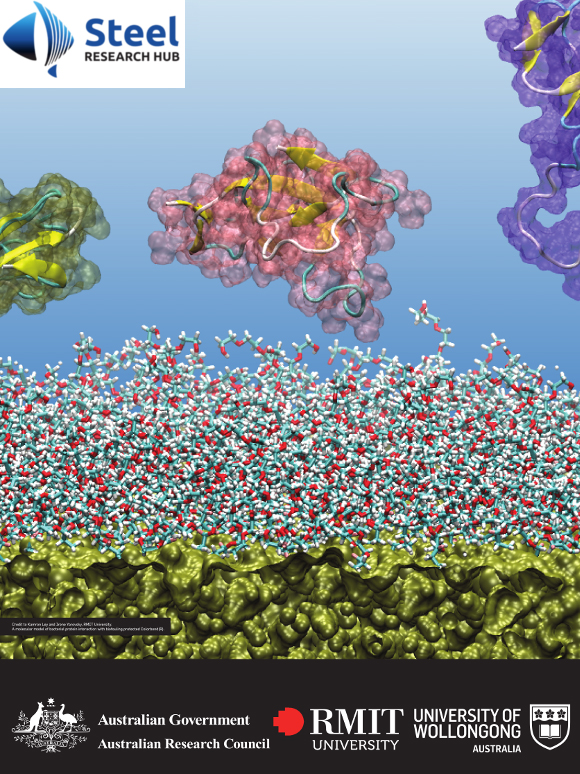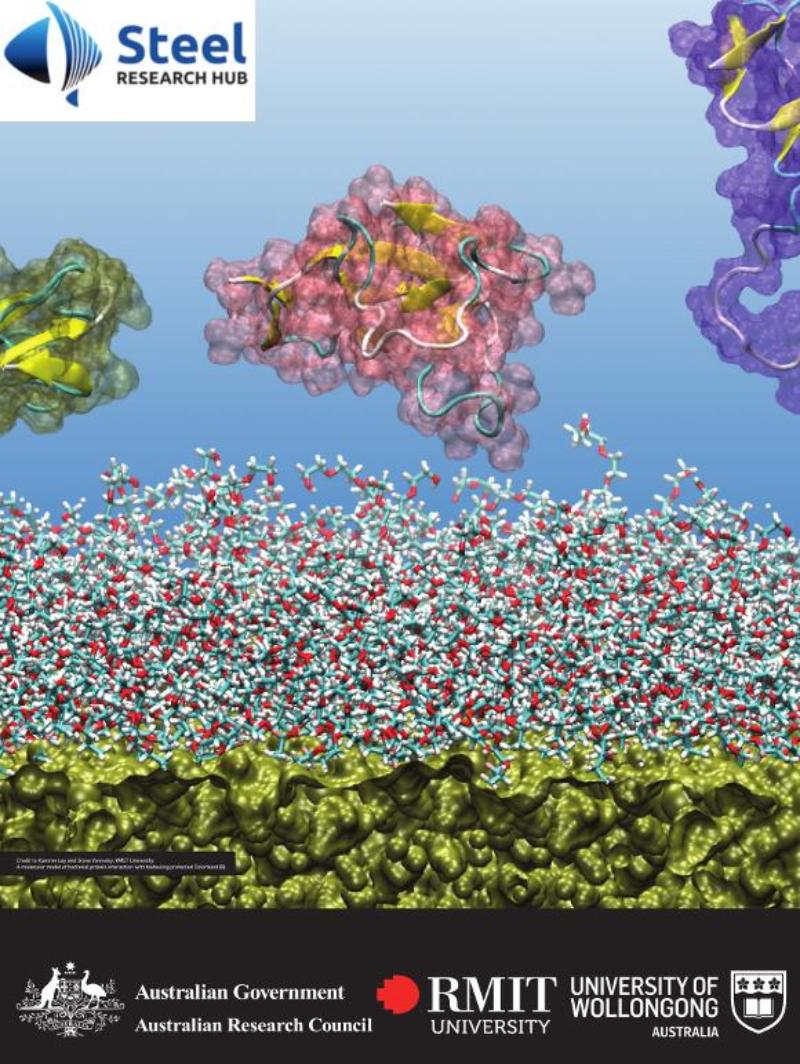Our research team is responsible for the theoretical modelling project aiming to optimise the molecular design of coatings for resistance to biological contamination (bio-fouling).

Bio-fouling is one of the top priorities amongst the market driven product innovations in coating technologies. We employ advanced computational modelling techniques to understand the molecular mechanisms of the interactions of biomolecules with engineered surfaces and assess the antifouling ability of various functional grafted chains.
These studies will help design surface treatments to prevent microbial and fungal adhesion which is an issue of paramount importance for manufacturers of industrial and biomedical coatings and materials. We use the latest techniques in computational modelling of atomic structure of biomolecules and surfaces to explore the molecular mechanisms of their interactions.
We work with our collaborating experimental research teams and BlueScope Steel, a world class steel manufacturing company.
 Molecular model of an antifouling coating created by RMIT modelling team for the HUB launch at the Parliament House (credit to SAMME PhD student Kamron Ley and Professor Irene Yarovsky).
Molecular model of an antifouling coating created by RMIT modelling team for the HUB launch at the Parliament House (credit to SAMME PhD student Kamron Ley and Professor Irene Yarovsky).
Media releases
- "Sticky" water holds the key to antifouling surfaces. A media release on our 2018 ACS Nano paper by phys.org
Grants and funding
Funded by the ARC Research Hub for Australian Steel Manufacturing (IH130100017) 2014-2019. The ARC Research Hub for Australian Steel Manufacturing, headquartered at the University of Wollongong, was officially launched at Parliament House by Minister for Industry, the Hon. Ian Macfarlane MP on 4 September 2014.
The Hub is supported by industry and university investment of more than $17 million and ARC funding of $5 million over five years. The ARC Research Hub is engaged in developing breakthrough process and product innovations to solve complex challenges confronting the Australian steel industry.
Key people
- Distinguished Professor Irene Yarovsky, ARC Chief Investigator and Hub Project Leader
- Dr Matthew Penna, research fellow
- Kamron Ley, PhD student
Partners
- Professor Michael Higgins, University of Wollongong
- Professor Margaret Sunde, University of Sydney
- Professor Elena Ivanova, Swinburne University of Technology
- ARC Centre of Excellence for Electromaterials Science
- Bluescope Steel Pty Ltd
Publications
Application of Molecular Simulation to Coatings Design, G. Yiapanis, D. J. Henry, E. J. Evans and I. Yarovsky, in "Nanotechnology in Australia: Showcasing Early Career Research", Eds. D. M. Kane, A. P. Micolich and J. R. Rabeau, ISBN: 9789814310024, Pan Stanford Publishing, 2010
2015-2019
- Integrating machine learning with all-atom simulations to understand structural and functional aspects of antifouling surfaces, T. Le, M. Penna, D. Winkler, I. Yarovsky, Scientific Reports, 9 (2019) 265 DOI:10.1038/s41598-018-36597-5
- Hydration Layer Structure of Biofouling Resistant Nanoparticles, P. J. Molino, D. Yang, M. Penna, K. Miyazawa, B. R. Knowles, S. McLaughlin, T.Fukuma, I. Yarovsky, M. J. Higgins, ACS Nano, 12 (2018) 11610–11624
- New mechanism of biowires formation by self-encapsulating Gluconobacter oxydan,V. K.Truong, C. M. Bhadra, A. J. Christofferson, I. Yarovsky, M. Al Kobaisi, C. Garvey, O. N. Ponamoreva, S. V. Alferov, V. A. Alferov, P.G. T. Perera, D. H. K. Nguyen, J. Wang, R. Buividas, S. Juodkazis, R. J. Crawford, E. P. Ivanova, ACS Omega, 2017, 10.1021/acsomega.7b01282
- Surface heterogeneity: a friend or foe of protein adsorption – insights from theoretical simulations, M. Penna, K. J. Ley, S. Maclaughlin and I. Yarovsky, invited contribution, Faraday Discuss., 191 (2016) 435-464, DOI: 10.1039/C6FD00050A
- Nanoparticles with Morphological and Functional Anisotropy, Applications: general discussion, A. Striolo, F. Sicard, L. Liz-Marzán, C. Murphy, A. Roig, A. Mueller, J. Reguera, Y. Zhou, M. Brust, L. Scarabelli, L. Tadiello, A. Thill, I. Yarovsky, M. Mayer, M. A. López-Quintela, C. Kuttner, E. Gonzalez Solveyra, H. Wolf, E. Kay, L. Pasquato, D. Buceta, D. Portehault, H. Mattoussi, G. González, R. Faller, D. French, B. Abécassis, M. Stevens, Y. Xia, R. Jones, M. Grzelczak, M. Penna and C. Drummond, Faraday Discuss., 91 (2016) 565-595, DOI: 10.1039/C6FD90051H
- Effect of Substrate on the Responsive Behaviour of Functionalised Surfaces: insight from Molecular Simulation, K. J. Ley, L. A. Shaw, G. Yiapanis, S. MacLaughlin, and I. Yarovsky, Molecular Simulation, invited, special issue dedicated to I. K. Snook, 42 (2016) 563-572
- Surface-water interface induces conformational changes critical for protein adsorption: Implications for monolayer formation of EAS hydrophobin, K.J. Ley, A. Christofferson, M. Penna, S. MacLaughlin, D. Winkler, and I. Yarovsky, Frontiers in Molecular Biosciences, 2015, 2:64
- Direct dry transfer of chemical vapor deposition graphene to polymeric substrates, G.J.M. Fechine, I. Martin-Fernandez, G. Yiapanis, R.V. Bof de Oliveira, X. Hu, I. Yarovsky, A. H. Castro Neto, B. Özyilmaz, Carbon, 83 (2015) 224-231
2010-2014
- Nanoscale Wetting and Fouling Resistance of Functionalized Surfaces: a Computational Approach, G. Yiapanis, S. Maclaughlin, E. Evans and I.Yarovsky, Langmuir 30 (2014) 10617−10625
- Surface Crosslinking Effects on Contamination Resistance of Functionalised Polymers, L. A. Shaw, G. Yiapanis, D.J. Henry, S. MacLaughlin, E.Evans and I. Yarovsky, Soft Matter, 9 (2013) 1798-1806
- Effect of Substrate on the Mechanical Response and Adhesion of PEGylated Surfaces: Insights from All-Atom Simulations, G. Yiapanis, D.J. Henry, S.MacLaughlin, E.J.Evans and I. Yarovsky, Langmuir 28 (2012) 17263-17272
- Simulations of Nanoindentation of Polymer Surfaces: Effects of Surface Cross-Linking on Adhesion and Hardness, G. Yiapanis, D. J. Henry, E.J. Evans and I. Yarovsky, J. Phys. Chem. C, 114 (2010) 478-486
2005-2009
- Molecular Dynamics Study of Polyester Surfaces and Fullerene Particles in Aqueous Environment, G. Yiapanis, D.J. Henry, E.J. Evans and I. Yarovsky, J. Phys. Chem. C, 112(2008)18141
- Effect of ageing on interfacial adhesion of polyester and carbon based particles: a Classical Molecular Dynamics Study, G. Yiapanis, D. Henry, E. Evans and I. Yarovsky, J. Phys. Chem. C, 111 (2007) 6465
- A Molecular Dynamics study of siloxane diffusion in a polyester-melamine solution, D. Henry, E. Evans and I. Yarovsky, Polymer, 48 (2007) 2179-2185.
- The Effect of Surface Composition and Atomic Roughness on Interfacial Adhesion between Polyester and Amorphous Carbon, G. Yiapanis, D. Henry, E. Evans and I. Yarovsky, J. Phys. Chem. C, 111 (2007) 3000-3009.
- Colorbond® meets Nanotech: understanding coating’s interactions with the environment, I. Yarovsky, D. Henry, G. Yiapanis, E. Evans, Chemistry in Australia, 2006, 73, 3, 11-13. Feature article (invited).
- Classical Molecular Dynamics Study of [60]Fullerene Interactions with Silica and Polyester Surfaces, D. Henry, E. Evans and I. Yarovsky, J. Phys. Chem B., 2006, 110, 15963-15972.
- Adhesion between graphite and modified polyester surfaces: a theoretical study, D. Henry, G. Yiapanis, E.Evans and I. Yarovsky, J. Phys. Chem. B, 2005, 109, 17224-17231.
- Theoretical Study of Adhesion between Graphite, Polyester and Silica Surfaces, D.J. Henry, C. A. Lukey, E.J. Evans, and I. Yarovsky, Molecular Simulation, 2005, 31, 449-455.
2000-2004
- Computer Simulation of Structure and properties of crosslinked polymers: application to epoxy resins, I. Yarovsky, E.Evans, Polymer, 2002, 43, 963-969.


